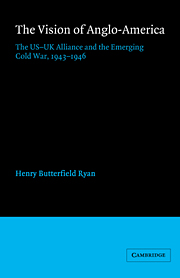Book contents
- Frontmatter
- Contents
- ACKNOWLEDGEMENTS
- INTRODUCTION
- PART I STRENGTHENING THE TIES: THE EFFORT AND THE PROBLEMS
- PART II FOREIGN CRISES THAT DEMONSTRATE GREAT BRITAIN'S PROBLEMS
- INTRODUCTION
- 5 Background and build-up
- 6 Involvement of Great Britain and the United States
- 7 Yalta and after
- 8 Truman: the new factor
- 9 The gathering for the San Francisco Conference
- 10 Between San Francisco and Potsdam
- 11 Concluding thoughts on the Polish crisis
- 12 Background of the crisis
- 13 1944, the critical year
- 14 The role of the press
- 15 The crisis peaks
- 16 America dives in
- CONCLUSION
- NOTES
- BIBLIOGRAPHY
- INDEX
7 - Yalta and after
from PART II - FOREIGN CRISES THAT DEMONSTRATE GREAT BRITAIN'S PROBLEMS
Published online by Cambridge University Press: 07 December 2009
- Frontmatter
- Contents
- ACKNOWLEDGEMENTS
- INTRODUCTION
- PART I STRENGTHENING THE TIES: THE EFFORT AND THE PROBLEMS
- PART II FOREIGN CRISES THAT DEMONSTRATE GREAT BRITAIN'S PROBLEMS
- INTRODUCTION
- 5 Background and build-up
- 6 Involvement of Great Britain and the United States
- 7 Yalta and after
- 8 Truman: the new factor
- 9 The gathering for the San Francisco Conference
- 10 Between San Francisco and Potsdam
- 11 Concluding thoughts on the Polish crisis
- 12 Background of the crisis
- 13 1944, the critical year
- 14 The role of the press
- 15 The crisis peaks
- 16 America dives in
- CONCLUSION
- NOTES
- BIBLIOGRAPHY
- INDEX
Summary
The meeting at Yalta was a milestone in the affairs of the Allied powers in relation to Poland. The questions of both eastern and western boundaries came up for an enormous amount of discussion as did the issue of the future Polish Government. The eastern boundary was determined along lines the Soviets had long established. Poland was denied Konigsberg and Vilna (the latter city also had long been in question), and was deprived of the city and province of Lwow. North of Lwow, the Curzon Line applied.
It is ironic perhaps that at this point settling the western boundaries became the more difficult problem, with the West wanting less for Poland, the Soviets more. Because both the Lublin Committee and the émigré government agreed that there should be no Germans in Polish territory, Churchill told the Commons that he estimated that six million Germans would have to be relocated if the Oder were to become the new border. Harriman calculated that ‘several million more’ would have to migrate if the Neisse River, as well as the Oder, formed the border, and worried about consequent demographic problems. Eden, whose calculations agreed roughly with those of Churchill and Harriman, said that more than eight million Germans would be uprooted by the Soviet–Lublin proposals. He, like Churchill, was worried about the stability of both Germany and Poland under these circumstances because of the economic and administrative problems involved, to say nothing of the humanitarian issues.
- Type
- Chapter
- Information
- The Vision of Anglo-AmericaThe US-UK Alliance and the Emerging Cold War, 1943–1946, pp. 87 - 98Publisher: Cambridge University PressPrint publication year: 1987



